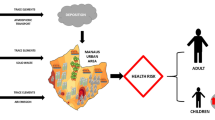Abstract
The integrated characteristics of urban soils included the assessment of heavy metal pollution linked to the determination of soil genotoxicity, which characterizes the soil capacity to affect the structural and functional state of the genetic apparatus of soil biota. Increased concentration of chromium caused by the high background level was found in soils of the city of Rostov-on-Don. A weak contamination of surface horizons with lead and arsenic was also noted. Maximum permissible concentration of zinc was locally exceeded, including deep soil horizons. It was found that there is no definite correlation between the total content of heavy metals, their mobile compounds, and the parameters of genotoxicity in the natural and anthropogenically transformed soils. It was concluded that soil genotoxicity characterizes the total mutagenic activity associated with the presence of a set of genotoxicants of different nature.
Similar content being viewed by others
References
V. V. Akimtsev, A. V. Boldyreva, S. N. Golubev, et al., “The content of microelements in soils of Rostov oblast,” in Microelements and Natural Radioactivity (Rostov State University, Rostov-on-Don, 1962), pp. 37–42.
A. S. Bagdasaryan, “Efficiency of the test-systems for analysis of toxicity of natural media,” in Ecology and Industry in Russia (Moscow, 2007), pp. 44–48.
O. S. Bezuglova and M. M. Khyrkhyrova, Soils of Rostov Oblast (Southern Federal University, Rostov-onDon, 2008) [in Russian].
A. K. Butorina and V. N. Kalaev, “Analysis of sensitivity of different criteria in cytogenetic monitoring of Zebrina pendula Schnizl,” Russ. J. Ecol. 31 (3), 186–189 (2000).
T. V. Varduni, Candidate’s Dissertation in Biology (Voronezh, 1997).
T. V. Varduni, “Free radical processes and the level of chromosomal aberrations in the leaves of wood plants as the test-systems for gene-toxicity of urban environment,” Ekologiya, No. 4, 270 (2000).
E. N. Gapon, “Study of exchange adsorption. 1. Exchange of two ions with the match of exchange ability and absorption capacity,” Zh. Obshch. Khim. 7 (10), 1468–1473 (1937).
S. N. Gorbov and O. S. Bezuglova “Specific features of organic matter in urban soils of Rostov-on-Don,” Eurasian Soil Sci. 47 (8), 792–800 (2014). doi: 10.1134/S1064229314080043.
S. N. Gorbov and O. S. Bezuglova “Elementary composition of humic acids in urban soils by example of Rostov-on-Don,” Pochvovedenie, No. 11, 1316–1324 (2013). doi: 10.7868/S0032180X13090025
S. A. Gostimskii, M. I. D’yakov, E. V. Ivanovskaya, and M. A. Monakhova, Manual on Cytogenetics (Moscow State University, Moscow, 1974) [in Russian].
S. E. Dyatlov, “Role and place of biotesting in complex monitoring of pollution of marine environment,” Ekol. Morya, No. 51, 83–87 (2000).
T. I. Evseeva and S. A. Geras’kin, “The effect of 232Th on the spiderwort (clone 02): single and combined with the salts of heavy and alkaline metals,” Radiats. Biol. Radioekol. 40 (4), (2000).
Classification and Diagnostic System of Russian Soils (Oikumena, Smolensk, 2004) [in Russian].
V. V. Koval’skii, Geochemical Ecology: Surveys (Nauka, Moscow, 1974) [in Russian].
Yu. L. Meshalkina and V. P. Samsonova, Mathematical Statistics in Soil Science (Moscow State University, Moscow, 2008) [in Russian].
T. M. Minkina, G. V. Motuzova, and O. G. Nazarenko, “Interaction of heavy metals with the organic matter of an ordinary chernozem,” Eurasian Soil Sci. 39 (7), 720–726 (2006).
T. M. Minkina, G. V. Motuzova, and O. G. Nazarenko, Composition of the Heavy Metal Compounds in Soils (Everest, Rostov-on-Don, 2009) [in Russian].
A. V. Mirzoyan, Candidate’s Dissertation in Biology (Rostov-on-Don, 2001).
O. A. Neverova and E. Yu. Kolmogorova, “Xerophytization of the leaves of wood plants as the indicator of air pollution (by example of city of Kemerovo),” Lesn. Zh., No. 3, 29–33 (2002).
Norms and Rules of the Design of Complex Constructions in Moscow (Moscow, 2006) [in Russian].
T. V. Prokof’eva, M. I. Gerasimova, O. S. Bezuglova, K. A. Bakhmatova, A. A. Gol’eva, S. N. Gorbov, E. A. Zharikova, N. N. Matinyan, E. N. Nakvasina, and N. E. Sivtseva, “Inclusion of soils and soil-like bodies of urban territories into the Russian soil classification system,” Eurasian Soil Sci. 47 (10), 959–967 (2014). doi: 10.1134/S1064229314100093
L. K. Sadovnikova, D. S. Orlov, and I. N. Lozanovskaya, Protection of the Environment from Chemical Pollution (Vysshaya Shkola, Moscow, 2006) [in Russian].
Yu. E. Saet, B. A. Revich, E. P. Yanin, et al., Geochemistry of the Environment (Nedra, Moscow, 1990) [in Russian].
E. V. Sen’kevich, Candidate’s Dissertation in Biology (Voronezh, 2007).
E. V. Shunel’ko and A. I. Fedorova, “Acidity of soils under green plantations in Voronezh as the indicator of urban ecosystems,” Vestn. Voronezh. Univ., Ser. Geogr. Geoekol., No. 4, (2000).
Ecology of Novocherkassk: Problems and Their Solution, Ed. by N. V. Belousova (North Caucasian Scientific Center, Rostov-on-Don, 2001) [in Russian].
D. C. Adriano, Trace Elements in Terrestrial Environments (Springer-Verlag, New York, 2001).
Th. Eikmann and A. Kloke, “Nutzungsund schutzgutbezogene Orientierungswerte fur (Schad-) Stoff in Boden,” UDLUFA-Mitt., No. 1, 19–26 (1991).
J. F. Hodgson, W. L. Lindsay, and J. F. Trieveiler, “Micronutrient cation complexing in soil solution. II: Complexing of zinc and copper in displaced solution from calcareous soil,” Soil Sci. Soc. Am. Proc. 30, 723–726 (1966).
M. Hoodaji, M. Ataabadi, and P. Najafi, “Biomonitoring of airborne heavy metal contamination,” Air Pollut.–Monit., Model., Health Control 21, (2012). http://wwwintechopencom/books/air-pollutionmonitoring-modelling-health-and-control/biomonitoring-ofairborne-heavymetal-contamination
Author information
Authors and Affiliations
Corresponding author
Additional information
Original Russian Text © S.N. Gorbov, O.S. Bezuglova, T.V. Varduni, A.V. Gorovtsov, S.S. Tagiverdiev, Yu.A. Hildebrant, 2015, published in Pochvovedenie, 2015, No. 12, pp. 1519–1529.
Rights and permissions
About this article
Cite this article
Gorbov, S.N., Bezuglova, O.S., Varduni, T.V. et al. Genotoxicity and contamination of natural and anthropogenically transformed soils of the city of Rostov-on-Don with heavy metals. Eurasian Soil Sc. 48, 1383–1392 (2015). https://doi.org/10.1134/S106422931512008X
Received:
Published:
Issue Date:
DOI: https://doi.org/10.1134/S106422931512008X




